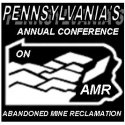 EPCAMR rehabilitated the Lewis Mine Passive Treatment System to improve the efficiency of the Successful Alkalinity Producing System (SAPs) and Vertical Flow Pond (VFP) to treat polluted mine water and restore the downstream water quality improvements of Birch Creek, tributary to the Loyalsock Creek, a reputable trout fishery. The project addressed mine drainage pollutant load reductions to Birch Creek and the Loyalsock Creek that had a previously developed TMDL. The original treatment system was installed in 2007 and was in need of maintenance and rehabilitation. The passive system consisted of primarily a small basin (forebay) and 13,000 sq. ft. vertical flow pond (VFP) filled with limestone and mushroom compost.
EPCAMR rehabilitated the Lewis Mine Passive Treatment System to improve the efficiency of the Successful Alkalinity Producing System (SAPs) and Vertical Flow Pond (VFP) to treat polluted mine water and restore the downstream water quality improvements of Birch Creek, tributary to the Loyalsock Creek, a reputable trout fishery. The project addressed mine drainage pollutant load reductions to Birch Creek and the Loyalsock Creek that had a previously developed TMDL. The original treatment system was installed in 2007 and was in need of maintenance and rehabilitation. The passive system consisted of primarily a small basin (forebay) and 13,000 sq. ft. vertical flow pond (VFP) filled with limestone and mushroom compost.
The VFP operates by vertical flow of AMD down through organic substrate and limestone aggregate, where the water is collected in an underdrain and discharged to a rock channel through a water level control structure. It was designed to effectively neutralize acidity and removed metals. First, the site was reclaimed in 2011 which involved the backfilling of a large pit that was hydrologically connected to the discharge and the surface application of biosolids. The discharge was less acidic, but contained more iron than was the case before the reclamation occurred. Second, in September 2011 Tropical Storm Lee produced 6-9 inches of rain locally. Erosion to a portion of the VFP berm and the emergency discharge channel indicated extremely high flow rates that overwhelmed the system’s hydraulic capacity and carried sediment into the VFP. Last, in the summer of 2012, the VFP became densely vegetated with nut sedges. The VFP was intended to be an open water system with negligible growth by emergent plants. Inputs of sediment and dense growth by plants decreased the permeability of the organic substrate and explain the head losses.
The VFP was rehabilitated so that it treated the discharge as originally designed. The rehabilitation included repairs to the system caused by Tropical Storm Lee, correction of the substrate permeability problem, design and installation of a settling pond that will allow solids to be trapped when the system is flushed, as necessary, that is conveyed by a newly constructed rock-lined channel and buried pipe to collect the braided deposition of solids below the current discharge outflow channel.
PROJECT TIME LINE
February 19, 2013 through December 31, 2016
PROJECT COSTS
$104,424 (SMCRA Grant) + $16,365 (Matching Funds) = $120,789
PROJECT GOALS
EPCAMR’s goal was to rehabilitate the Lewis Mine Passive Treatment System to improve the efficiency of the Successful Alkalinity Producing System (SAPs) and Vertical Flow Pond (VFP) to treat polluted mine water and restore the downstream water quality improvements of Birch Creek, a tributary to the Loyalsock Creek, a reputable trout fishery. Reduce the iron loading. Reduce the acidity loading. Increase the alkalinity loading of the discharge prior to its confluence with Birch Creek to improve the water quality and downstream fishery habitat in the Loyalsock Creek Watershed.
PROJECT RESULTS
Pollutant load reductions that can be attributed to the implementation of this project (e.g. sediment, N, P, Fe, Al, Mn, Acidity, etc.). Acidity loadings have been reduced by 50 pounds per day. Iron loadings have been reduced by 4 pounds per day. Excess Alkalinity has been increased to 82 pounds per day. Aluminum and Manganese levels remain unchanged and have not been seen as detrimental to the effective treatment of the rehabilitation of the Lewis AMD Treatment Rehabilitation. Over the 20 year life span of the system, it is anticipated that Acidity load reduction would be 365,000 pounds (182.50 Tons), Iron Load reduction would be 29,200 pounds (14.6 Tons), and Excess Alkalinity increased from the treatment system would be 598,600 pounds (299.3 Tons).
The project occurred in two phases. Phase I involved repairs to the VFP system, installation of a rock-lined conveyance channel and installation of a new settling pond. Phase II involved changes to the organic substrate to eliminate permeability issues.
PARTNERS
Eastern PA Coalition for Abandoned Mine Reclamation (EPCAMR), managed and oversaw the project and provided the grant administration that allowed Hedin Environmental, who originally designed the system, and Rexer’s LLC, out of Dushore, PA, a local construction contractor, to coordinate the design, construction, and final completion of the rehabilitated Lewis Mine Passive Treatment System at the Guten Mine Drift, with full cooperation and access provided by Mr. Marc Lewis, private landowner of the property, which was under the Dwight G. Lewis Testamentary Business Trust. EPCAMR also conducted outreach within Sullivan County, PA and had the full support of the Sullivan County Conservation District, Loyalsock Creek Watershed Association, PA Association of Conservation Districts, and the White Ash Land Association, all local partners within the region.
LESSONS LEARNED
The successes of the project were an improved Lewis Passive Treatment System capable of treating additional volumes of mine drainage from the Guten Drift due to the increased surface area and permeability of the limestone and organic matter that was replaced. The berm of the VFP was shored up and compacted from the earlier historic storm events and high water events to solidify the northwestern end of the pond. A new series of weirs and a flume was installed to obtain more accurate measures of future flows and to calibrate them to be able to take easier readings of volumes of mine water flow in the future. An emergency spillway channel was constructed in case of high water emergencies. Sedges that were overgrown in the VFP were removed improving the efficiency of the treatment system. A buried piping system for future flushing, if needed was constructed over the steep hillside, that now will carry the treated water into the lower wetlands flushing pond that was also constructed, should it be necessary. Bedrock and broken rock that couldn’t be used in the base of the lower pond was set aside to create rock habitat windrows on site for small mammals, snakes, and other wildlife. Mr. Marc Lewis has agreed to allow EPCAMR and or the Sullivan County Conservation District to work with the local schools in the future to provide tours to the treatment system location and utilize it as an educational area for Sullivan County students. Rexer’s LLC had great experienced operators working on the job and they made provisions for all of our requests and communicated with EPCAMR, Hedin, Mr. Lewis, and the PA DEP Moshannon DMO, whenever a problem might have been foreseen on site when digging and excavating the lower pond and the rock-lined channel and piping into the lower flushing pond. EPCAMR kept all local partners apprised of the project’s progression and they were updated on key completion points of the project throughout the last two years. Hedin Environmental’s construction management was key to implementing the project with very little major modifications to what we originally had set our goals on accomplishing, other than moving the location of the lower pond to a location a little further northeast than we had anticipated due to the amount of glacial material, bedrock, and an outcropping of rock strata that had all of us reconsider the location for the final flushing pond.
WATER QUALITY PRE TREATMENT POST TREATMENT
Guten Mine Drift– pH 4.2 (Before) pH 7.3 (After) leaving Lewis Mine AMD Treatment System and Lower Pond
16 ppd Acidity (Before) -66 ppd Acidity (After) leaving Lewis Mine AMD Treatment System and Lower Pond
6 ppd Iron (Before) 2 ppd Iron (After) leaving Lewis Mine AMD Treatment System and Lower Pond
< 1 ppd Aluminum (Before) < 1 ppd Aluminum (After) leaving Lewis Mine AMD Treatment System and Lower Pond
2 ppd Manganese (Before) 2 ppd Manganese (After) leaving Lewis Mine AMD Treatment System and Lower Pond
88 ppd SO4 (Before) 82 ppd Excess Alkalinity added leaving Lewis Mine AMD Treatment System and Lower Pond
35 gpm average flow (Before) 36 gpm average flow (After) leaving Lewis Mine AMD Treatment System and Lower Pond
1410 Tons of Limestone Utilized 225 Tons of Organic Matter .16 aerobic acres of wetlands created 20 year life span and sludge capacity












You must be logged in to post a comment.